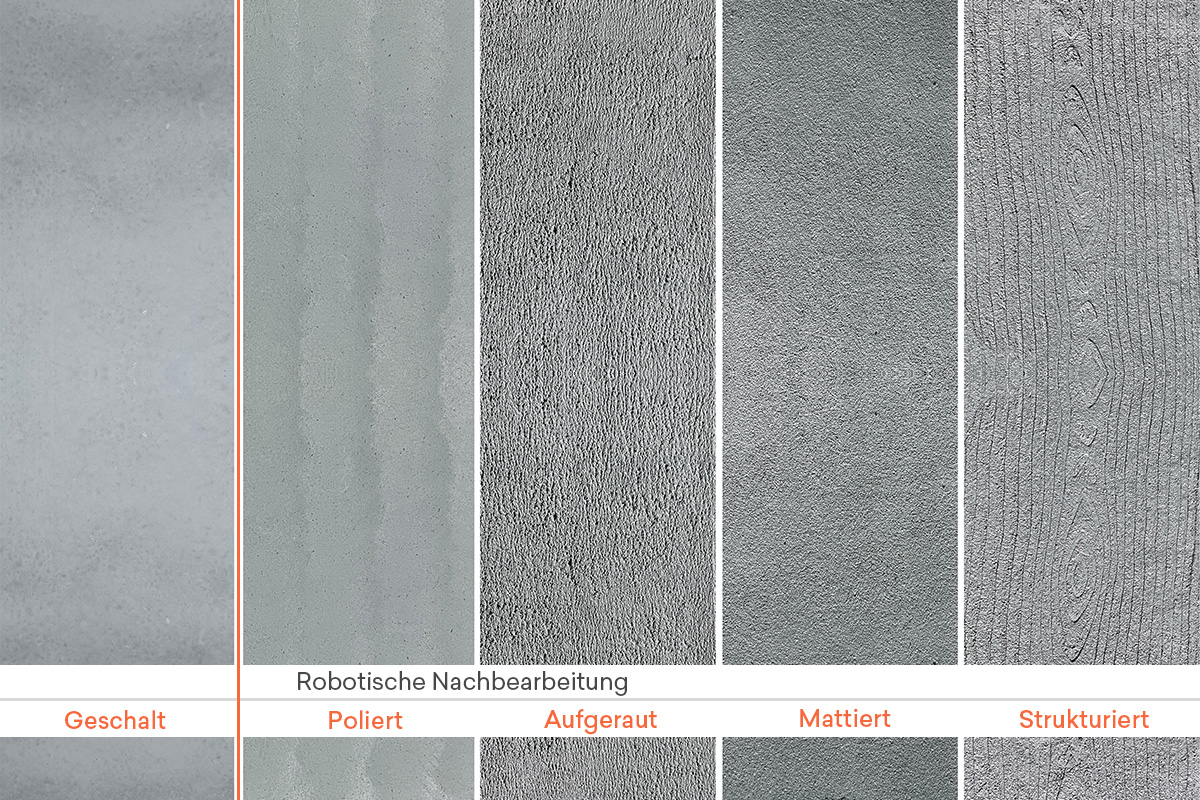#Concrete Aeditor #Technologies & Trends
Class struggles – Is 3D printed concrete defying traditional categories?
Innovations and technological advances can not only set new standards in manufacturing and production but also challenge established quality criteria and classifications. A case in point is exposed concrete that is created without formwork using Robotic Shotcrete Printing technology.

Throughout its success story, concrete has earned its place a functional building material but also as a versatile design element. Irrespective of its aesthetic classification, exposed and untreated concrete has been a widely used architectural concept since the Brutalism movement of the 1950s. The term “Brutalism” is not derived from the English word “brutal” but rather from the French term “béton brut,” which was used by architects like Le Corbusier to describe visibly raw concrete, commonly known as architectural or exposed concrete.
Today, exposed concrete comes in various forms, which are achieved by treating fresh concrete surfaces, post-curing processes such as stone-like finishing, milling, acid etching, washing, or coloring. The techniques used to create textured and structured concrete surfaces are diverse. What they all have in common, however, is that their appearance is shape to a greater or lesser degree by the surface of the formwork used for casting.
Concrete classes for exposed concrete surfaces – a quality standard for formwork concrete
In 2004, the German Concrete and Building Technology Association (DBV) defined a classification for exposed concrete surfaces in its technical bulletin on architectural concrete. The bulletin outlined the associated technical and design requirements. This classification, along with the introduced nomenclature, facilitated communication among clients, architects, planners, and construction professionals by establishing uniform evaluation and quality standards for exposed concrete surfaces. It is evident that these quality criteria were defined with traditional formwork concrete in mind. The classes describe and regulate various aspects, including texture, porosity, color consistency, flatness, construction joints, formwork joints, and formwork classes.
Here is a brief summary of the four concrete classes:
- SB1: Concrete surfaces with no or minimal design requirements, typically found in basements or predominantly commercially used (storage) areas.
- SB2: Concrete surfaces with moderate design requirements, such as staircases and ancillary spaces.
- SB3: Concrete surfaces with high design demands, primarily for exterior applications, such as facades in high-rise buildings.
- SB4: Concrete surfaces with exceptional design significance, for example, representative components in high-rise structures.
Due to its applicability and widespread use in formwork concrete, this classification has become the de-facto standard for exposed concrete. It is now the universally accepted quality benchmark for defining and assessing precast concrete surfaces. Formwork concrete has become so prevalent in concrete component production that whenever architectural concrete is mentioned, smooth formwork or the classification of formwork classes are automatically considered.
The construction industry in transformation – 3D printing sets new standards
The construction industry is undergoing a significant transformation. The pressure for change is greater than ever due to labor and skilled worker shortages, climate change, and geopolitical uncertainty. The driving forces of innovation, digitization, connectivity, and automation are giving rise to new technologies and manufacturing processes. In short, everything around us is changing.
In the field of precast concrete manufacturing, 3D printing is taking efficiency and sustainability to the next level. Our Robotic Shotcrete Printing (RSP) method, based on regular shotcrete, is setting new standards. It combines a multitude of matchless features, including excellent layer adhesion, the integration of reinforcements, and the ability to realize highly optimized component geometries with our flexible nozzle. But most importantly, the printing process is formwork-free. While this offers advantages in terms of time, cost and waste, the formwork-free process also presents new challenges for the treatment of surfaces.
Innovations must meet existing standards
We are well aware that innovations generally need to meet existing expectations and standards in order to be accepted and embraced by the market. This means that our precast components must be measured against the industry standards of exposed concrete classes, even if they are produced entirely without formwork. That’s why the Concrete Aeditor includes a second robot responsible not only for positioning reinforcements and embedded elements but also for post-processing the rough surfaces after printing. We have invested a lot of time and effort in fine-tuning and optimizing these processes. As a result, we can now achieve a very high surface quality with a fine and uniform appearance. In terms of the overall aesthetics, its appearance is comparable to concrete cast using formwork.
However, achieving a surface identical to that of traditionally cast concrete which would withstands close inspection is still not feasible within reasonable time and cost constraints, but our work continues.
Innovations can set new standards
Not having to rely on formwork during the manufacturing process means that Concrete Aeditor is able to create a variety of novel surface structures in a cost-effective way. It is crucial to explore the possibilities offered by this new technology, and looking at our European neighbors, we see that a wide range of concrete surfaces are being designed in Switzerland, for example. However, their production has traditionally involved highly skilled craftsmanship, which is why they have been rarely sought after or offered in industrial prefabrication. Formwork-free concrete printing could open up new paths here and give concrete a fresh look.
Conclusion – standards must keep pace with progress
With Concrete Aeditor, we already achieve surface quality comparable to traditional formwork concrete. At the same time, formwork-free 3D concrete printing as an innovative technology enables new possibilities that go far beyond imitating traditional manufacturing methods. To fully exploit this potential, suitable evaluation and assessment criteria are needed. Over time, the concrete classes for exposed concrete will have to evolve to classify high-quality surfaces without referencing formwork.
Finally, it is worth mentioning that while discussions about surface are justified , the structural integrity of concrete is of vital importance, and in this aspect, our Concrete Aeditor achieves excellent and consistently high quality due to the automated manufacturing process.
Get in touch to find out more about RSP.
